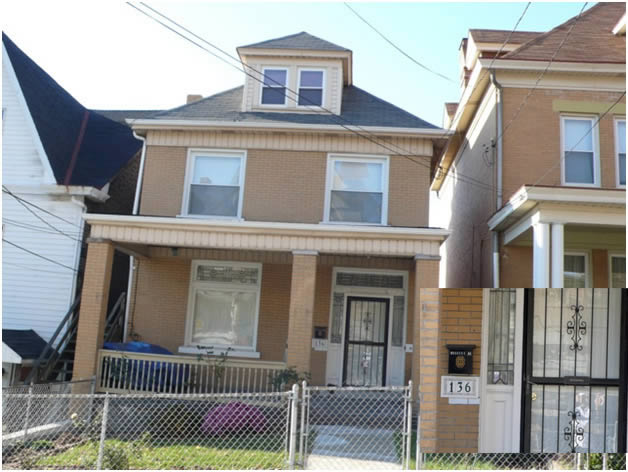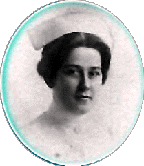
My mother's home in Pittsburgh - 136 Ulysses Street
___________________________________________________

My
mother, who died in 1987 at the age of 95, was a remarkable person. Of
Irish and Alsace-Lorraine ancestry, she was born into genteel poverty
in Pittsburgh, Pennsylvania at the end of the 19th century. Of she and
her 8 brothers and sisters, only three survived into adulthood. I remember her telling us that while her mother was giving birth to her in an upstairs room, her sister Maisie was "laid out"
in the parlor below, having died at an early age.
Her sister
Sara died at 50, but her older brother John lived to be 99 years old.
Helen
Burrey left school and went to work at age 14 at Hornes, a department store
in Pittsburgh, joining her older sister Sara in the hat depatment. They were supporting her widowed mother. She worked there until she entered nursing school at
St. Francis Hospital. When World War One began, she volunteered to serve
as an army nurse. She was one of the first to be sent to France. What
follows this introduction is an excerpt from the Official History of
the Red Cross, published in the 1920. It has become a treasured family
memento. In addition to her input to this official history, she kept
journals and made scrapbooks of her experiences on the hospital troop
trains in France. We treasure these also.

Portait of my mother before she went to France.
In 1931,
Helen married a man who had been her brother John's best friend.
My
father, Charles Brown, was a gentle, handsome bachelor of 44. She
was 39. The first years of their marriage, which was long and happy,
were shadowed by the depression. They sacrificed to give us everything,
including education in a private school.

My Dad
I remember her as the kindest and most loving of parents. She thought
of great imaginative games for my younger brother and myself, and
never tired of stimulating our minds and caring for our bodies. I
still have the "special" tea set she saved to serve us when
we were ill.
She could paint in oils, wallpaper a whole house, plant thriving gardens,
and volunteer to help where she could. She was the first in the neighborhood
to visit new arrivals, always with a freshly baked cake or cookies.
My children and my brother's children were lucky to have her with
them at our homes until the end of her life. The least she deserves
is this small tribute.
Helen
T. Burrey, reserve nurse, Army Nurse Corps, a graduate of St. Francis
Hospital, Pittsburgh, Pa., and a member of the nursing staff of U.
S. Army Base Hospital No. 27, was one of the first three nurses to
be assigned to hospital trains of The American Expeditionary Forces.
She wrote:
Base
Hospital 27, located at Angers, France, received the first official
order dated July 14, 1917, to supply Army nurses for this service.
Until this time, the Medical Corps attached to hospital trains were
caring for the wounded. Through Miss Blanche Rulon, chief nurse of
Base Hospital 27, Edna Cooper, Grace O'Donnell and I were detailed
to Hospital Train 57.
When
told that we were to leave the next day to board this train which
was then stationed at Port Boulet, France, we were certainly filled]
with a spirit of adventure. We arrived at Port Boulet July 15, found
our train and made ourselves known to the commanding officer, Captain
Goodwin, who had knowledge of our coming. He received us very kindly
and immediately showed us to our quarters.
We were agreeably surprised at the modern equipment. In our coach
there were three compartments which consisted of a dining room and
two sleeping rooms and a lavatory (tri-angular in shape) containing
a small wash bowl and commode. The sleeping rooms were made up of
a private room consisting of one berth and a wardrobe and a second
room which contained a lower berth and an upper berth. Of course,
we all wanted the private room, but since it could not be private
among three, we resolved to take "turns about" and rotate
from upper berth to private room. The rule was one week in the private
room and the next week, in the lower berth and the third week in the
upper berth. As we had five months of this life, we had plenty of
time for the private room. The dining room, which was also used as
a living room, contained a table and two chairs and a side seat fitted
to the wall.
Miss Burrey described the accommodations of Hospital Train No. 27:
The
rest of the train consisted of sixteen coaches, including one infectious
car which carried eighteen beds; one staff car which carried eight
beds; one kitchen and sitting sick officers' car which carried three
beds and twenty seats; eight ordinary lying ward cars which carried
288 beds; one pharmacy car; one infectious case sitting car which
carried fifty-six seats and fourteen upper berths; one kitchen and
mess car with three beds for cooks; one personnel car with thirty
beds and one train crew and store car; the total capacity of the train
was thus 400 beds.
Each moving hospital was equipped with electric lights, steam heat,
electric fans, lavatories and racks for personal belongings and even
ash trays for the patients' indulgence. There were eight ordinary
ward cars for patients containing thirty-six beds arranged in tiers
of three. These could easily be converted into seats to accommodate
patients who were able to sit up; they could also be used for stretchers
in emergency cases or folded against the sides of the coach when the
cars required cleaning.
Miss Burrey wrote of the trial trip of Train No. 57, when for the
first time American Army nurses were officially assigned to train
service:
Our
first trip was to evacuate patients from different hospitals who were
able to be moved to a point of embarkation for the United States.
Since we were the first nurses, Colonel Howard Clark, who was then
in charge of the train service, made the first trip to these different
hospitals; this was also the first trip for transporting badly wounded
patients from the hospitals near the front to the hospitals near the
point of embarkation.
We started July 17, passed through Tours, Bourges, Nevers, Dijon,
Chaumont, Neufchateau, Contrexville, Toul and Savenay, stopping at
several base hospitals and filling our train with wounded who were
to be taken to Base Hospital No. 8 at Savenay. After seeing our work,
Colonel Clark congratulated us and recommended that all the trains
be supplied with three nurses.
We worked day and night with those patients; the pathetic condition
of our boys who were very badly wounded made us realize that being
wounded was hard enough to bear, without the jolts, noise and dirt
connected with traveling on a train. These patients were in our care
for two nights and three days before they were loaded at Base hospital
No. 8. I remember two patients who had broken backs and had horrible
bed sores. You can picture the special care such a case would require,
but our time with each patient was limited and we gave the best attention
possible. We also had many patients who had amputations of legs, or
arms, and many other wounds that caused much pain and constant attention
from doctors and nurses.
One of the chief discomforts which we noticed that the patients met
was caused by the tightening of bandages due to the restless position
of the patient and by the moving and stopping of the train. This condition
was also aggravated by the infected wounds and the patients were constantly
calling for relief from the bandages.
During the drives which centered in the Chateau-Thierry sector, work
on all hospital trains of the American Expeditionary forces was heavy.
Miss Burrey wrote:
During
the drive at Chateau-Thierry a great number of the hospital trains
were mobilized at Pantin, a suburb of Paris, for duty into Chateau-Thierry.
From Paris to Chateau-Thierry was about three hours ride and 27 was
ordered to make the trip. The train was sent to evacuate patients
from hospital No. 7, a mobile unit. These patients had received First
Aid; major operations were cared for. Some had hardly reacted from
their anesthetic and most of them were in a pitiable state.
In
the station and surrounding it were litters covered with boys; mud-splattered
and torn were the uniforms they wore. They were patiently waiting
to be to be taken, they did not care where but some place where they
could be given proper care. After we received our train load, about
400 patients, one of the things that bothered both patients and nurses
most were the countless numbers of flies that infested our train.
The odors from the wounds that had no care cannot be described but
shall live in the memory of the nurses and orderlies. We made three
trips to Chateau-Thierry. The third one was to a small town outside
of Chateau-Thierry. It was after dark when we got there and we immediately
started to load our train with patients that had been gassed. At the
height of our work, we had an alarm of the enemy airplanes which meant
all lights out and we had to work in the dark getting as many patients
under shelter as possible. We loaded our train without keeping count
of the patients that could walk. After the train pulled out and we
got to a place of safety, the lights were turned on and we found we
had patients everywhere, in the berths, on the seats and crowded in
the aisle.
Hospital service formed one of the most adventurous and interesting
branches of war nursing. Miss Burrey wrote:
To
get to a certain base hospital, which was in a mountainous district,
the train had to be divided; the engine could not pull the entire
train up the mountain. We got no instructions as to the splitting
of the train, so it was just luck that all the nurses were not in
one part of the train. I found myself on one half of the train, garaged
in a railroad yard with about two hundred patients; the other half
with two nurses was starting up the hill. While they were gone, an
engine was attached by mistake to our train and soon we were rapidly
moving away. We traveled about eight hours before we finally found
the rest of our train. We were surely happy to see them again, for
they happened to have the supply and the kitchen car.
When the train was empty and we were moving, the scenery and the wonderful
views of France thrilled us, but when the train stopped, we were garaged
in some railroad yard. We might stay there an hour or maybe two days
before our train was ordered to move. You can picture the average
train yard in America; picture it in France in war times!
When we nurses would get off the train to stretch our leg we were
greatly amused at ourselves. We felt like three geese walking along,
for we noticed we trailed one another. Did you ever see geese walking,
one in the lead and the other following? We used to do that till we
realized we were not on the train any longer but out in the street,
and then we would chuckle to ourselves. Our reason for doing this
was that the aisle in the train was so narrow that we had to walk
single file.
Back
to top of page. |



